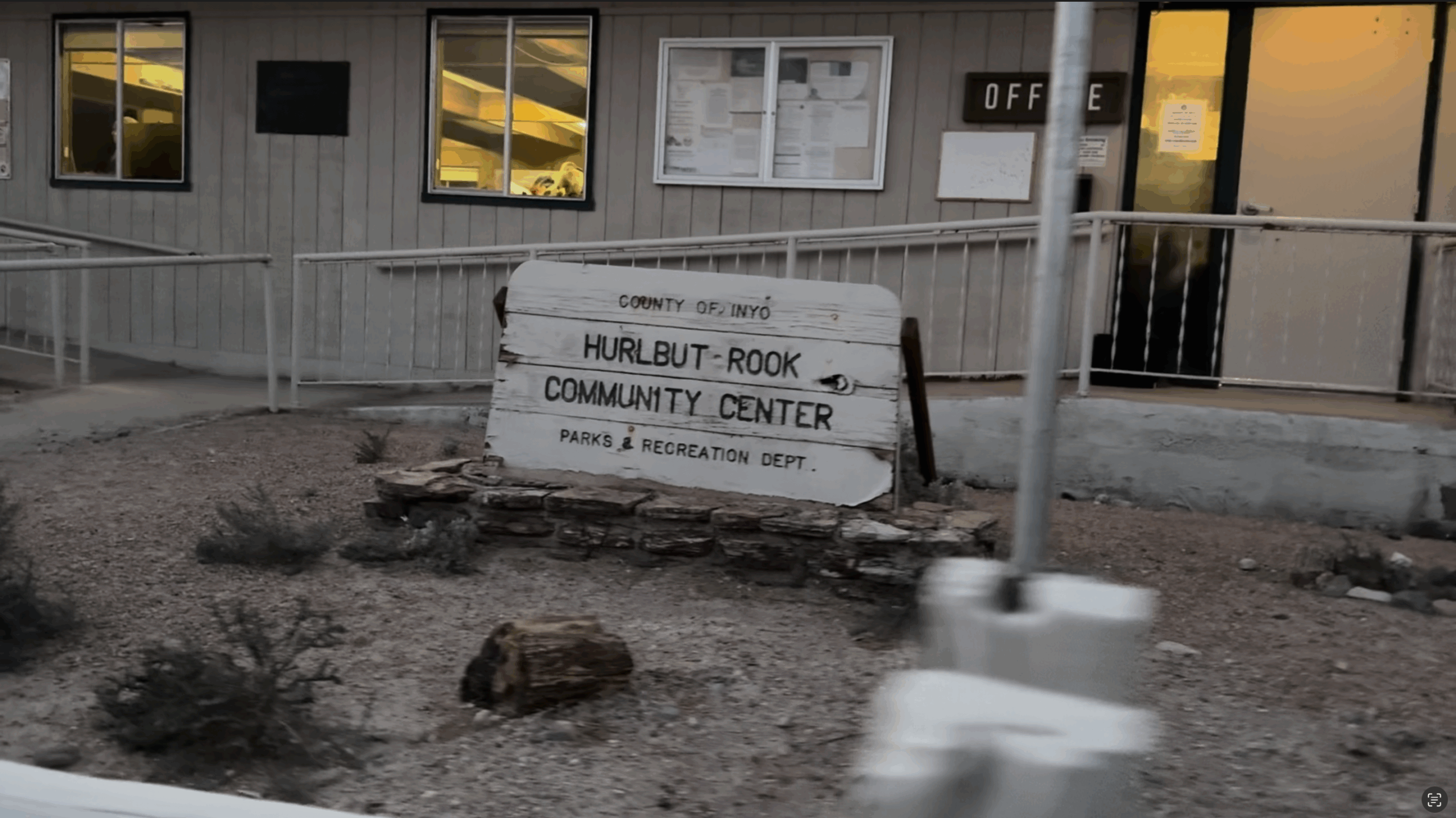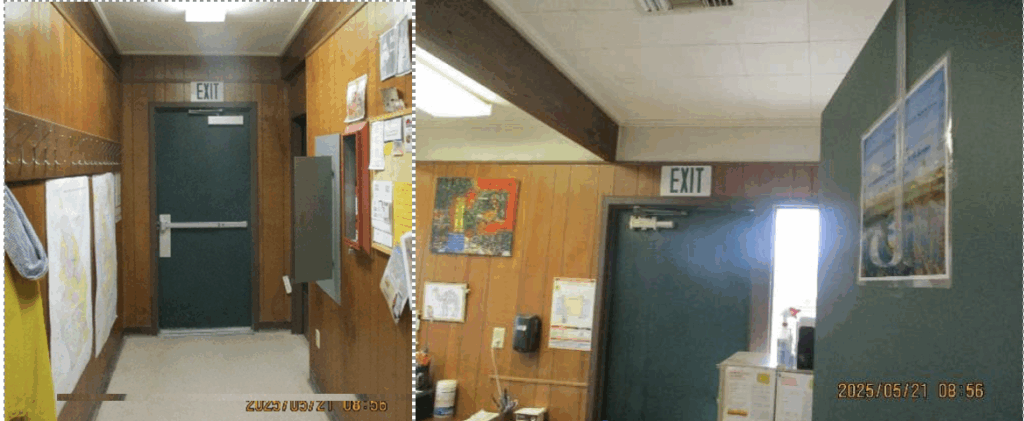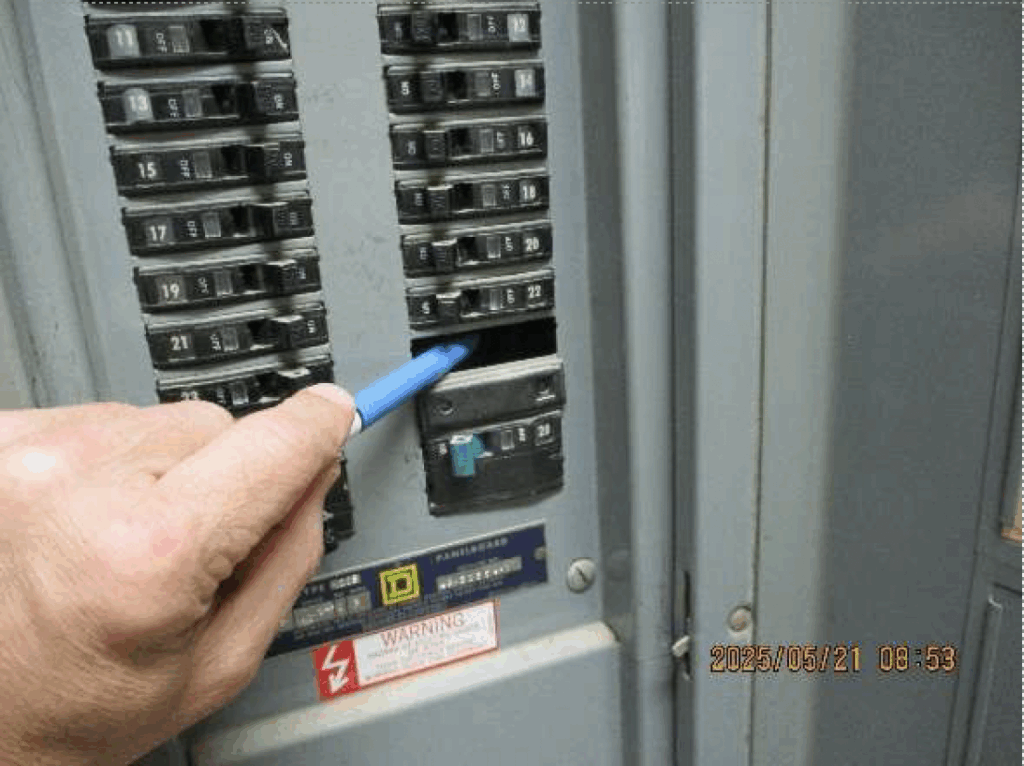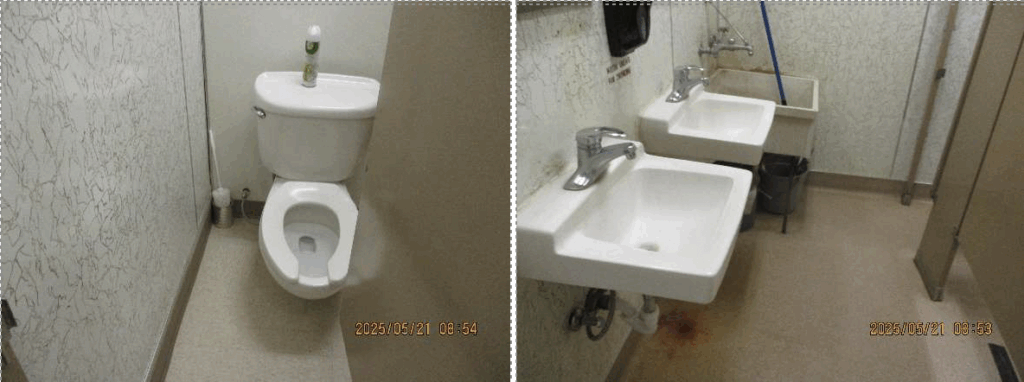
“It gets very dark here in the winter,” wrote Aaron Holmberg, Inyo County’s Assistant Director of Risk Management, in his 2024 safety report on the Tecopa Community Center. “The exit signs are needed, especially if the power goes out earlier or later in the day for staff.”
If you’ve ever wondered how slow progress looks in government time, look no further than the Tecopa Community Center—our little desert hub for board meetings, town halls and summer survival.
Each year, Holmberg drives a few hundred miles from Bishop to check that we’re not about to electrocute, dehydrate, or trip over ourselves. And bless his bureaucratic heart—he’s been documenting our quirks in fine print for many years running.
Over the past three years, a series of Inyo County Risk Management audits have quietly documented the transformation of the Tecopa Community Center—from a well-loved desert gathering space with aging infrastructure into a facility now poised for long-term stability and modernization.
The reports, written annually by Holmberg, offer a rare window into the county’s methodical effort to maintain essential services in one of California’s most remote towns. Reports from 2023, 2024, and 2025 trace a story of persistence, partnership, and slow but steady progress in meeting safety, accessibility, and climate-readiness goals.
Taken together, these three annual audits tell a slow-moving story about rural resilience. Each year, Holmberg finds many of the same things: the propane tank that can’t get permitted, the exit signs that flicker in and out, the concrete that cracks and lifts in the heat. But each year, he also finds progress—and people who care enough to keep fixing what they can.

From Small Fixes to Systemic Change
The 2023 inspection read like a friendly check-in. Holmberg commended staff for keeping the community center “in great shape,” listing only a few minor issues: clearing clutter under desks, smoothing concrete on the patio, and fixing non-illuminating exit signs. The only serious finding was an unpermitted propane tank—a problem that would become a running theme in the years that followed.

By 2024, the tone shifted. Holmberg’s report—addressed jointly to facility managers and county administrators—took on a broader scope. Safety remained a priority, but planning for the future entered the conversation. He called for illuminated exit signs (still not repaired from the prior year), replacement of the faulty kitchen range hood, and continued pursuit of the elusive propane permit. More significantly, he urged the county to develop a Capital Improvement Plan for Tecopa facilities, noting the community center’s potential role as a “cooling site of last resort” in the face of extreme desert heat and Tecopa’s penchant for losing power.
“It was 105 degrees outside and only 79 degrees inside,” he observed during the summer inspection. “We are currently doing exceptionally well with indoor heat management… however, we may wish to build better infrastructure to be prepared.”
A Facility Grows Up
The 2025 audit, conducted this May, found the center in “much improved” condition. Two of four exit signs now illuminate properly, the patio has been repainted, and the building’s overall maintenance has noticeably advanced. Yet, the report pressed forward on deeper issues—ones that tie the facility’s future to countywide modernization efforts.

The electrical panel had a hole where a safety block should be (“taped over for now”). Two of four exit signs now light up—progress!—but the north-end west door still needs wiring. The propane tank, now officially identified as a “500-gallon 1994 Roye Hanson,” remains a relic of another era. Holmberg’s patience has worn thin: he’s now asking the County to replace it within the year.
And because Tecopa’s community center doubles as a cooling site, he added a new item: the restrooms must be upgraded to ADA standards. He admitted it might not happen until 2026 or 2027, but the message was clear—the desert’s public spaces must catch up with the century.

“Let’s avoid having these items on next year’s report,” Holmberg wrote, signaling a new phase of accountability that blends praise with clear deadlines.
The Big Picture: Rural Resilience in Real Time
Viewed together, the three reports chronicle not just facility maintenance but a county’s evolving understanding of what resilience means in rural Inyo.
What began as a list of simple housekeeping fixes in 2023 has grown into a full-scale plan to ensure Tecopa’s community center can withstand both the demands of public service and the challenges of a changing climate. The annual audits have become an unlikely form of documentation—capturing, in bureaucratic language and dated memos, a story of public stewardship in a place where distance and desert heat often slow progress.
Each year the same details reappear: propane tanks, exit signs, cracked patios. Yet beneath the repetition lies a gradual layering of care—a recognition that small rural facilities like Tecopa’s are lifelines for isolated residents, whether in a heatwave, a flood, or a blackout.
A Long Road Ahead
As of 2025, the Tecopa Community Center still faces a checklist of work orders—replacing old equipment, upgrading restrooms, and securing long-deferred permits. But the trajectory is unmistakable.
In a region where county staff travel hundreds of miles to conduct inspections, Holmberg’s reports stand as quiet testaments to endurance: the long, often invisible labor of keeping a desert town safe, habitable, and ready for the next chapter.
Through three years of Holmberg’s audits, the community center stands as both a symbol of effort and a reminder of how fragile progress can be. The building is cleaner, safer, and closer to code than it’s been in years. But it’s also carrying the weight of Tecopa’s future—as a meeting hall, an emergency shelter, and the desert’s unofficial cooling station.
What began as a few notes about paint and patio cracks has evolved into a blueprint for resilience—one that, year by year, reflects Tecopa’s growing ability not just to endure the desert, but to adapt to it.
About This Series
Paper Trails is a recurring TecopaCabana feature that translates the fine print of county memos, state audits, and official letters into the stories they quietly tell about life on the desert’s edge.

Leave a Reply